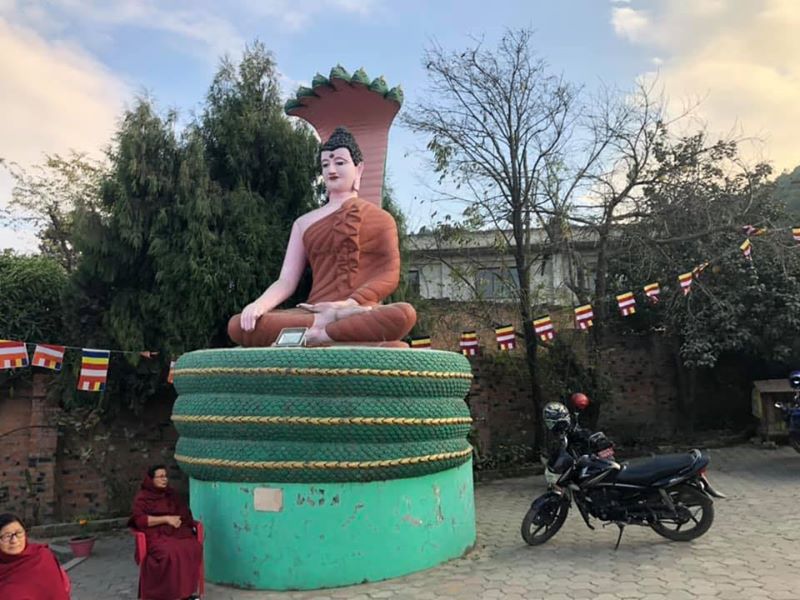An incident between Lord Shakyamuni Buddha and the serpent, Mochalinda
Prazol Maharjan | Youtube: Prazol Vlogs | Follow: Instagram | jhigunepa@gmail.com
 |
| Photo: Chilancho Vihar, Kirtipur, Nepal. Naresh Maharjan, 11.2019 |
Ci-Ba-Dyy (चि:बा द्य्य)
Below stone statute is known as Ci-Ba-Dyy (चि:बा द्य्य) in Nepal Bhasa. This kind of statue can be seen in every courtyard, throughout the Kathmandu valley, occupied by Newars. Ci-Ba-Dyy, is carved with Panca Buddha (पन्च बुद्ध - the Primordial Buddhas, five meditating Buddhas) with each one of them facing different directions. Among the five meditating Buddhas in this statue, one of the Buddhas, (as highlighted below), facing North direction, is always carved with a serpent over his head. Every Ci-Ba-Dyy (चि:बा द्य्य) is designed this way. The Buddha facing the North direction, is Amoghasiddhi Buddha (one of the Pancha Buddhas), depicting the same incident of Lord Shakyamuni Buddha with the serpent.
 |
| Photo: Ci-Baa-Dyy (चि:बा द्य्य), Maru Tole, Kathmandu. Prazol Maharjan, 2014 |
The Myth of Relating Shakyamuni Buddha as the 9th avatar of Hindu God, Lord Vishnu
The above magnificent statue is located in the courtyard, outside my house in Kathmandu, Nepal. I find it sad when I see many people misrepresenting the Lord Buddha, as being the 9th avatar of Lord Vishnu without proper knowledge and facts to support such hoax. Lord Vishnu is one of the most revered Hindu deities, usually seen laying on the bed, made of the serpent, providing shelter to him. This incident of Shakyamuni Tathagata with the Serpent has nothing to do with Lord Vishnu, it is completely irrelevant. Lord Buddha is not an avatar of any Hindu God. Shakyamuni Buddha is not the only Buddha who came here, many Buddhas have came before him and many more will come after him. Before becoming a Buddha, Lord Shakyamuni took millions of birth in many forms on the Earth.
Shakyamuni Buddha, before becoming a Buddha took millions of birth. He worked hard and made numerous sacrifices to benefit all the sentient beings, in every birth. The merits he earned in each life cycle, kept pushing him closer and closer towards the ultimate goal of becoming the Buddha. Eventually, on his final birth as a human in the form of, King Bishanker (बिशंकर राजकुमार), he has fulfilled all the requirements including, 10 paramitas (१० पारमिता ), 10 upa paramitas (१० उप परमिता ), 10 paramartha paramita (१० परमार्थ पारमिता ) and became fully qualified to become the Buddha. Thus, after the life of King Bishankar, he took birth in Tushita Bhuvan (तुशिता भुवन) as Swetaketu Bodhisattva (स्वेतकेतु बोधिसत्त्व). After that, his final life as Budhha, he took his last birth in Lumbini, Nepal.
In this way, in each life, Lord Shakyamuni Buddha did nothing but good for every sentient being and gained supreme merits and knowledge and eventually became Samyak Sambodhi Buddha, after attaining enlightenment. Thus, even the serpent, representing as Nature, came for the protection of such an enlightened being, during the rain storm.
Takeaway
This incident clearly shows that when you carry on a task with good intentions and a pure heart to benefit others, the road will not always be rainbows and flowers. You will come across many hindrances, which will test you. However, If you stick in the right path and continue with your duties, you shall reach your goal. Sometimes, we may think no one is watching just because no one is present, physically. Trust me, Nature has its ways, it takes account of everything. It goes along with one of the most popular lessons that Shakyamuni Buddha has preached, "You shall reap, what you sow", your future consequences are inevitably shaped by your present actions.
Lastly, I want to extend my thanks and regards to my two Teachers, Dr. Kabindra Bajracharya and Praksh Man Sakwo from the bottom of my heart for always inspiring me to write and enlightening me into Buddhism.
Below clip is the Mocalinda Pond in Bodhgaya
References:
Buddhist Practitioner, Dr. Kabindra Bajracharya, MD MA. Pediatric Ophthalmologist, Lumbini Eye Institute
Prakash Man Sakwo, Archaeologist / Historian, Sakwo (Sankhu)


Thanks for your explanation. I'm so happy on your words.
ReplyDeleteWarm wishes.